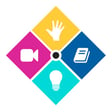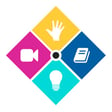Become a Creator today!Start creating today - Share your story with the world!
Start for free
00:00:00
00:00:01

OA of the IP joints
Recommended
Transcript
Introduction to Hand Therapy and Osteoarthritis
00:00:06
joshmacd
Hi, I'm Josh McDonald.
00:00:07
mmateri
And I'm Miranda Materi, and we are Hand Therapy Academy.
00:00:11
joshmacd
We're going to talk a little bit today about one, like a difficult diagnosis, a diagnosis that for me is one I struggle with how best to help patients because it's not one with great outcomes in general. And that's ah osteoarthritis specifically of the IP joints of the hands.
Challenges in Treating Osteoarthritis
00:00:27
mmateri
Yeah, I think um it's interesting because you were talking about your case and I actually had a very similar case with, and the patient was actually a physician and we were talking about what do you do when they're almost getting fused, right? And we know the only indication for an arthroplasty is pain because they don't typically improve joint range of motion. ah And so can you improve those? Can you prevent them from getting worse? Or are you going straight to adaptive equipment?
00:00:57
joshmacd
Yeah, and I had a patient come in, I don't know, three, four weeks ago, and I had the standard conversation. It was a referral test for hand therapy from a rheumatologist, and it was, here's adaptive equipment. Here's some modalities that can help with pain. Here's some energy conservation techniques, but there's not a whole lot we can do to change the status of your joints. And she was unhappy she said i came in here with some hope that maybe you could make it better and she was frustrated at me because she said you told me like and and i was in this stuck position because i tried to do it obviously very graciously and but at the same point like harry i'm telling her
00:01:34
joshmacd
your hands are where they are. And so when today's patient came in, I'm like, okay, I wanna have an even softer approach to that, but I shouldn't be doing aggressive range of motion to gain range. Some of those joints are close to fusion and hard end feel. I'm only gonna serve to either cause pain or increase damage.
Assessing Treatment Effectiveness
00:01:53
joshmacd
so It's a tough population to know how to feel like you're being helpful for them.
00:01:56
mmateri
Yeah. And sometimes for those patients too, I'll be like, you know, I'm happy. I'm going to try it. You know, I'm going to try my best and do everything I have in my toolbox to help you. And I want you to know that a lot of times when I see these patients that they don't improve, but let's try it for three weeks and see where you're at. And if you're getting better, we continue on. And if, if it's no longer beneficial, then you know, we, we are done basically.
00:02:22
joshmacd
Yeah, do you see him once a week or twice a week?
00:02:25
mmateri
Um, it just depends on if I feel like the patient is really like motivated and they are, you know, though they can do it on their own. I might say once a week, but if I feel like they need more supervision and hand holding, then I'll do two times a week, you know, maybe we do six, a total of six visits and see where they're at.
00:02:38
joshmacd
Okay. And I tend to go to, like, i I told this patient, I evaluated today on Wednesday, I said, let's have you come in on Monday, that's five days away. And then depending on how it goes, we can see you again on Thursday or Friday, that's twice in the same week. Or if on Monday you feel like you're good with some home program stuff, we'll kick it to the following weeks and it becomes, so it's kind of like a PRN basis if we need it or not.
Patient Preferences and Customization
00:03:05
mmateri
Yeah, and I think you can tell right away the patients that want to be there, right? Like, or that feel like they might need a little more hand holding and those that just want to be independent.
00:03:14
joshmacd
Yeah, yeah, just show me some stuff to do at home. Yeah, and I've had, I've had patients
00:03:17
mmateri
Yeah.
00:03:20
joshmacd
Some of them more receptive, some of them less receptive to the basket of adaptive equipment we pull out. It's got an adaptive mouse and kitchen utensils and writing implements and a variety of button aids and that kind of stuff. And some are like, this is fantastic. And others have this like, yeah, I don't i can figure that stuff out on my own. So it's ah it's a difficult population that has wide swings of preferences in it.
00:03:40
mmateri
Yeah and then for a lot of our well ah a few years back we had a therapist that did her capstone with us and that's where they do a specialty rotation for four months and it's self-designed at whatever that student was interested in and I had a student that was really interested in um arthritis of the hand and she developed like this four-part program so each Treatment there is four different treatments in each treatment session focused on something else and a different aspect of it and um that was kind of that was nice and that's something we still will implement implement like we're over the session we're gonna be going over this stuff the next one that one and so making it more of a program and she ended up um getting accepted to AOA TA and getting it
00:04:21
mmateri
um She presented it there, which was a big deal for her. ah And for all of us, we're very proud. But I think sometimes, too, just having all those different things that we could work on was helpful. And and she had all like the citations, so we would provide the evidence of what's out there to the patients. And I think that's helpful.
00:04:36
joshmacd
Yeah, yeah.
Structured Treatment Programs
00:04:38
joshmacd
So what would you if there's four or five order? What were the tools in the toolbox that were like each individual sessions focus?
00:04:45
mmateri
Yeah, so one session was, the first session was just like a lot of education on what osteoarthritis is, you know, how it's different than the other types of arthritis, what makes it worse, what makes it better, like what exacerbates your symptoms. um it It was a, it was a really holistic program. So it might be, you know, different movement patterns that exacerbated, but it could also be, um we tried to stay away stuff that we weren't as, you know, informed about like nutrition and stuff like that but we would talk about you know a limited role about exercise and so that would be one section and then the next session they came in would be focused on exercises like safe exercises to do and then the next session would be all like adaptive equipment and so we'd have them bring in a list of like all the stuff they were having problems with and then go through that list and address it with adaptive equipment or maybe some joint protection principles.
00:05:36
joshmacd
Okay.
00:05:36
mmateri
And then you know I don't they think the last one was just kind of like a summary and a recap of everything.
00:05:42
joshmacd
Okay, okay, I like that.
Tailored Evaluations and Treatments
00:05:44
joshmacd
And that's similar to the the application of information when we're doing like a first CMC arthritis, OA, where we'll do a session that's maybe we get you into a splint and we work on a couple of adaptive equipment things. And the next session we talk about joint stabilization exercise. So it kind of partitions that out. and then you're not kind of shotgunning everything all the time and kind of all scattered.
00:06:07
mmateri
Right. And then I think going back to like the core of our evaluations is asking what's important to the patient. like Why are they seeing us? If we ask them that in the first session, like do you want recommendations on activity modification and joint protections? And if that's not one of their goals, then it's like, well, you know we could tell them we do that, and we're happy to talk to them about it if they're interested. But if they're not interested, it's hard to get people on board with some of that stuff. you know So during that first set, if it's pain relief, then I might show them joint wrapping and you know paraffin and things like that if it's range of motion then sometimes it's education on you know we're not going to be gaining a lot of range of motion but
00:06:44
joshmacd
Yeah, yeah. And so will you do, like if a patient has softer end feel on, let's say, their right hands, IP joints, and they're close to a full fist, but not quite, but it feels stiff, will you take them through or show them how to do self passive range of motion after modality? Or do you just say, use your hands functionally for as long as you can?
00:07:06
mmateri
I might show them, like it depends. I'll teach them to watch for signals. Like if your joint is inflamed, we don't want you to be pushing it and doing those things and making it worse. And then I go over, you know, the physiology of the joint and what makes it worse. And then, but if it's the joint is not inflamed, then I might show them a gentle passive range of motion and stretching and then gauge their response. I say, Hey, if you're having a lot of pain the rest of the day and into tomorrow, it means that you or me were too aggressive, so you need to back off of it.
00:07:37
mmateri
And this is very much something that if you do too much passive or you're too aggressive, you can deteriorate the joint more.
00:07:43
joshmacd
Yeah.
00:07:43
mmateri
What about you?
00:07:45
joshmacd
Yeah, I struggle with that as much because the patients so desperately want more range of motion.
Techniques for Pain Relief
00:07:52
joshmacd
And it seems almost like like we're keeping something back from them because I'm not going to stretch you. like i i I don't want to make things worse. And so I'll do, you and I kind of jokingly call it that loving touch. like that sense of like, I'm going to work with your hands. I'm not trying to gain more flexion of all the joints. I'm trying to i almost act as a modality. I think in that situation where I'm helping to um decrease pain sensitivity and more working on
00:08:20
joshmacd
working the joint through through its available range, but passively, as opposed to overpressure at the end range, as opposed to a low load prolonged stretch. I'm just trying to find the available range. And so that's more the passive range without the overpressure that I'll apply if that patient is desperately seeking that. And then like you said, say, how did that feel in the moment? And then when you come back next time, Have have paid attention to how you felt the next 24 hours was that fantastic was that worse or was it no different.
00:08:52
mmateri
Yeah.
Maintaining Patient Engagement
00:08:53
mmateri
Yeah. And I think a lot of it comes down to what the patient wants and their goals are, and then us trying to manage those goals and seeing if it's something we think that we can achieve together, you know, because a lot of times it might not be.
00:09:04
joshmacd
Yeah yeah. And it's not going to be a long term ongoing patient. It's not going to be someone that comes for, you know, six weeks, eight weeks or something. It's we have some tools to give you. We have some things we can help you with. It's just so as ah as someone who wants to help other people, it's kind of tough to have to tell them, like, that's maybe all we can do is help you not get worse fast.
00:09:24
mmateri
Yeah,
00:09:27
mmateri
yeah one thing I was at AHS this last year and I was staying to a talk by Wendell Merritt and he said that he thinks it does a lot of damage to I think he could call it the human spirit to tell people there's nothing meet more we can do or I'm going to discharge you now. And what he recommended or what his overall message was, hey, how about you follow up with me in a couple of months, you know, put you on the schedule if you don't need it, cancel it. But no, I'm not giving up on you. You know, I'm still here if you need me. And just I guess having that more human side where you're not only concerned about the pathology of the arthritis, you're also concerned about the individual as a human. And I thought that was like a really kind approach.
00:10:11
joshmacd
Yeah, yeah, very kind approach has a ah good awareness. And i I would imagine that by the time most of those patients get to six months out, they probably end up canceling those visits or not because they kind of come to that realization of I kind of am where I am, but it's a softer letdown.
00:10:29
mmateri
Yeah, it's a softer letdown. And I think if they come up with more questions or, you know, it doesn't seem like you're just dismissing them or, you know, inval I think a lot of times patients feel invalidated if we're not addressing their so or we're not able to address everything. So I guess I think just still being there and validating them.
00:10:46
joshmacd
Yeah, yeah, very cool. Okay, well, it's just good for us to sometimes talk about the diagnoses and things that don't always work out so great. And sometimes we aren't happy with the tools we have in our toolbox, but it's good to kind of share that experience and see what what others can learn from it too.
00:11:01
mmateri
Yeah.
00:11:02
joshmacd
Yeah. Well, if you guys have any questions, feel free to reach out to us on our emails, info at Hand Therapy Academy or on any of our social media platforms, Hand Therapy Academy.


